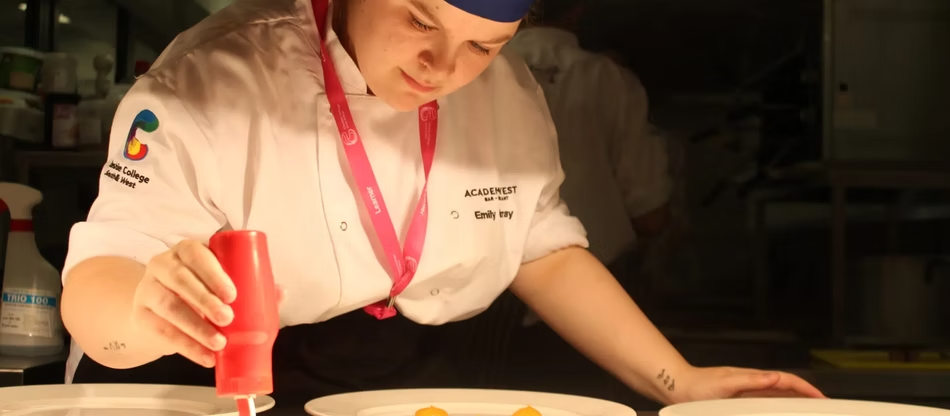Sally Abé’s “A Woman’s Place is in the Kitchen” is more than just a memoir; it’s a bold, inspiring exploration of Sallys journey in a male-dominated industry.
Having just finished reading it, I felt compelled to reflect not only on her journey but also on the impact she continues to have, especially after meeting her at The Art of Hospitality event.
In “A Woman’s Place is in the Kitchen,” Sally delves deep into her experiences, challenges, and triumphs as she rose through the ranks, from working at The Savoy to becoming the head chef of London’s only Michelin-starred pub and creating her own restaurant The Pem.
Sally shares some shocking stories from her time in the kitchen—from chefs taking bets on who would sleep with the new girl first, to being given offensive nicknames like ‘TitRat,’ to someone deliberately burning her in the kitchen.
Despite these horror stories, nothing has ever diminished her love for cooking. The book does an excellent job of showing just how passionate Sally is about cooking and the thrill she gets from a busy kitchen.
One moment from the book that really stuck with me was the moment Sally took her mum to dine at Claridge’s, the Michelin-star restaurant where she was working at the time. She shared how the staff went above and beyond, making them both feel like VIPs. Even the head chef offered to give Sally’s mum a personal tour of the kitchen. By chance, Gordon Ramsay was there that day. Sally mentioned she had only seen him once before, but he made her mum feel incredibly special, even speaking highly of Sally to her too.
This moment resonated with me because making our customers feel special, like true VIPs, is something I deeply believe in.
Going the extra mile to brighten someone’s day is at the heart of hospitality. Whether you’re doing it for your own mum, someone else’s, or even a complete stranger, those small gestures can feel like you’re giving them the world.
Sometimes, it’s as simple as offering a behind-the-scenes look at the kitchen or adding a personal touch that makes them feel valued and cared for. That’s what makes hospitality so rewarding – it’s all about making meaningful connections through these little moments.
Another moment in the book that has stayed with me is this metaphor Sally uses to describe the savoury kitchen and the Pastry kitchen:
“Someone once described the savoury part of the kitchen as a death-metal band, everyone rocking out, lots of screaming and chaos that creates something delicious, whereas Pastry is a finely tuned symphony orchestra with a precise, controlled crescendo. The whole kitchen comes together every night to work in harmony and create a musical masterpiece” (A Women’s Place is in the Kitchen p43)
It’s such a beautiful representation of the two worlds. What makes it even more interesting is that, traditionally, women tend to be pushed towards pastry in professional kitchens. It’s often seen as the ‘gentler’ path, with its precision and calmness, compared to the intensity of the hot kitchen.
But Sally makes it clear that she avoided the pastry kitchen as much as possible because she didn’t want to be pigeonholed into that stereotype.
It’s a great example of how she’s always challenged the expectations placed on women in the industry, carving her own path and inspiring others to do the same.
Reading Sally’s memoir, I couldn’t help but admire how she turned her passion for food into a platform for meaningful change, not just within her own kitchen but across the entire industry.
It started when she became the head chef at The Harwood Arms, making small but significant changes like consciously avoiding yelling or attacking her staff. She later introduced hourly pay and alternative work schedules, fostering a healthier work-life balance for her employees.
While these changes may seem small to outsiders, for those in the hospitality industry, they make a significant difference.
At my Art of Hospitality event, I was lucky enough to meet Sally in person after hearing her speak on our panel.
Sally was such a pleasure to be around, happily sharing details and talking about the yearly conference she hosts on International Women’s Day called ‘Empowering Women in Hospitality.’ It started as a simple 1-hour panel discussion but turned into a two-hour conversation about motherhood, pay, working hours, and so much more.
What’s amazing is how Sally really lives by the idea that ‘you can’t be what you can’t see.’ Growing up, she didn’t have many women to look up to in high positions, so now she’s working hard to change that.
By bringing women together, she’s helping them see that these leadership roles are totally within reach. It’s inspiring to see her creating opportunities for women to connect and support each other in this industry.
This has a similar baseline for what I’m aiming to do with my event The Art of Hospitality# – trying to get people excited about hospitality again and showing what an incredible industry, it is. By highlighting the people and stories that make it special, we’re helping more people see the amazing opportunities within hospitality.
Sally’s story is a powerful reminder that representation matters—whether it’s women in the kitchen or diversity in leadership it’s important that young people seem themselves in our industry.
If you missed our last Art of Hospitality event don’t worry because we are hosting our next one in January with even more amazing speakers form our industry!
Get your tickets here
https://www.tickettailor.com/events/thehospitalityheroltd/1247485?






